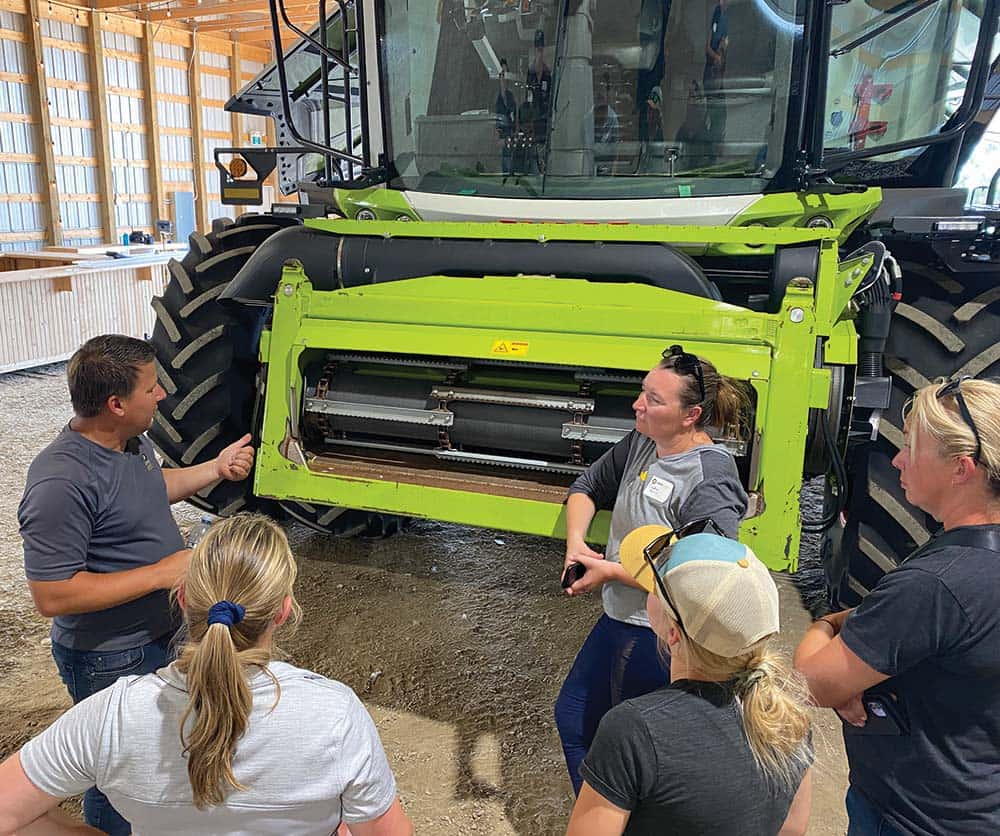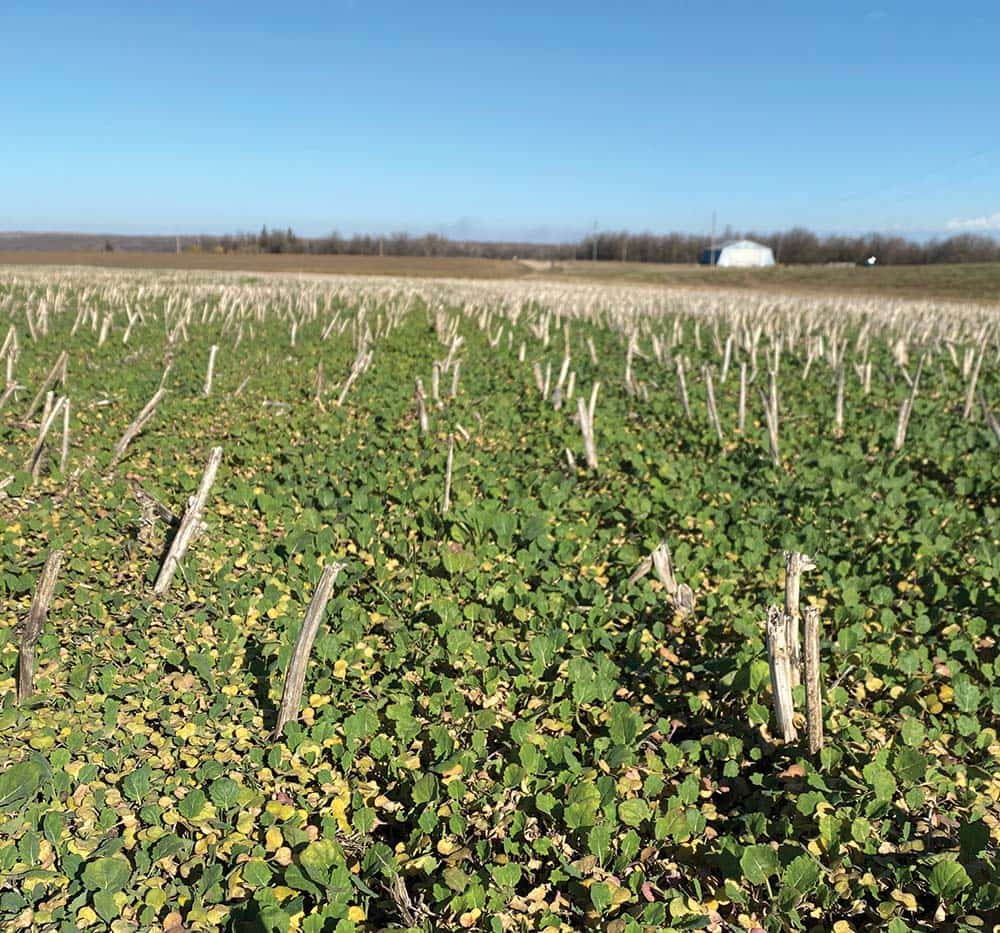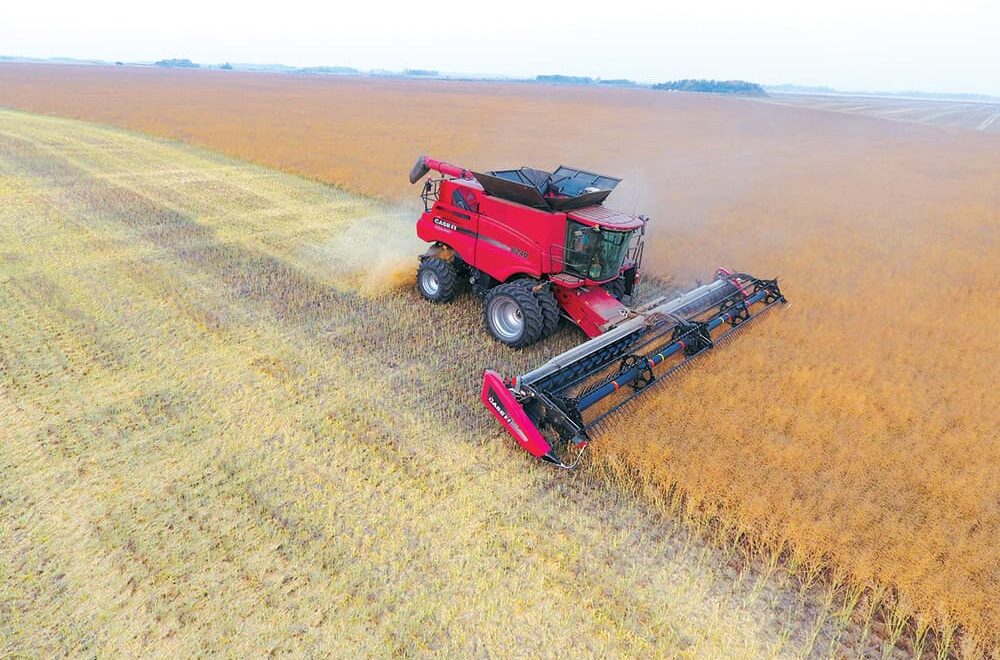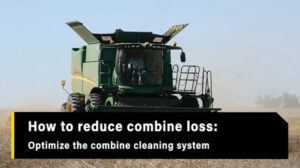Comfortable settings
Agronomist Candice Harris wants to help farmers every way she can, including at harvest. Harris, an agronomy lead with Simplot Grower Solutions, supervises agronomy staff at locations across northwest Saskatchewan. She brought three colleagues to the Canola Council of Canada’s half-day Combine Clinic for Agronomists in August 2023.
“Combine Clinic was an incredible hands on experience for my less-experienced staff. For my experienced staff, it was good for fine-tuning settings,” Harris says. Even so, Harris says she and her staff are not yet ready to give advice on combine settings.
Candice Harris (right), an agronomy lead with Simplot Grower Solutions, talks with Shawn Senko, agronomy specialist with the Canola Council of Canada, at last summer’s Combine Clinic for Agronomists.

“I feel like it’s something an agronomist could offer, but we need qualified staff to diagnose the issue and make a recommendation,” she says. “We’re quite knowledgable about drills – seeding depth, fan speed, checking for cracked seed. A combine is more complex.”
Harris thinks they’d need a combine school with a week of training. “If the dealerships would offer training, we would send staff,” she says. This past winter, Green Valley Equipment, a John Deere dealership network in south central Manitoba, hosted 50 farm women at its Morden training centre.
Try the Combine Optimization Tool at canolacalculator.ca
Tamara Babisky, a cattle and grain farmer from Brokenhead, Manitoba, helped organize the combine training session as part of the Manitoba Farm Women’s Conference. Babinsky is the primary operator of the farm’s John Deere combine. They also have a New Holland.
The session included videos and in-person discussion from a “great team of instructors”, Babisky says. They learned how excess dockage ends up in the hopper, how grain gets cracked or crushed, and how to measure losses. “It was informative for people with all levels of involvement with combines,” she says.
Scott Hildebrand, combine specialist with Green Valley Equipment, was one of the instructors. Hildebrand says they would offer these training sessions to other groups, including agronomists, if asked.
Harvest loss specialists ScherGain and Bushel Plus also have new programs to help combine operators reduce losses. ScherGain has a knowledge-sharing subscription service at combinesettings.com, where farmers learn from farmers. Bushel Plus has a new Harvest Academy for hands-on training. (See the sidebars for each.)
Shawn Senko, agronomy specialist with the Canola Council of Canada, says it would be difficult for agronomists to become familiar with all the makes and models their customers use. “It takes a while to become familiar with a machine, even after years of doing it. When I get a new one, it’s a steep learning curve,” he says. “But a basic understanding of settings to get a grower started would be possible.”
Ultimately, farmers want to figure out how to set their combines for minimal losses and maximum productivity in various conditions – from canola to wheat, from warm afternoons to damp evenings. “This takes some time with drop pans, but the end result should be a greater knowledge of the farm’s own combines,” Senko says. “With this knowledge, farmers can recognize their own loss levels and find their own threshold for acceptable loss.”
Spending money on some outside help– whether an agronomist, machinery company staff, a network of other farmers or combine loss specialists– will likely pay off.
This thick mat of volunteer canola, taken in the fall of 2023, shows the potential loss coming out the back of a combine. You don’t want to see this!

Harvest loss help – Q&A
1. Does your dealership or company have a quick set-up guide to help combine operators achieve minimal loss and maximum performance in canola?
Rick Hubrich, regional product supervisor for Claas in Regina, Saskatchewan: We have many videos online. Claas Connect and Cemos Advisor, an app, also help customers walk through the process to optimize their combines. These are free to download.
Scott Hildebrand, combine specialist with Green Valley Equipment (John Deere) in Morden, Manitoba: We do have a certain process in place and steps to test and set a combine for minimal loss while maximizing combine performance. It’s not as simple as following a check list though. It always starts with determining where the losses are coming from. Are they coming from the rotor/separator, or are they coming from the cleaning system? Once we have determined that, it helps us to know which settings or adjustments to tweak to help bring the losses down. There are far too many variables involved to be able to use the same process or settings every time. Some of the variables include the canola variety, stalk conditions, temperature, sunny or cloudy, moisture content, and standing or swathed. Even day to day within the same field or variety will often require the combine to be set differently.
Grant Milne, cash crop specialist for New Holland: We pre-programmed various crop settings into our IntelliView monitor. Canola is one option we offer as a pre-set crop. So while we do recommend doing some small tuning to your specific field needs, the computer in the combine can handle the vast majority of the settings on behalf of the operator to ensure maximize capacity and minimize crop loss.
2. What is the best way for a combine operator to learn how to minimize losses?
Scott Hildebrand: It’s an ongoing process. The combine needs to be tested regularly as conditions change throughout the day or even throughout the field. Producers that tend to use the same settings throughout the entire canola harvest will experience higher losses in certain conditions, quite possibly without even noticing it. The more you test within different conditions, the more you will learn where you need to set your particular machine to optimize its performance within that condition. Once you know what works, record it. Write it down, or save it as a preset on your combine’s monitor. Over time, you will develop an extensive database of combine settings for each variety or harvesting condition, and you won’t need to start from scratch. Additionally, modern combines use built-in technology to help automate this process. Learning how to leverage and properly use this technology is key to getting the most out of your investment in harvesting equipment.
Rick Hubrich: As mentioned, the apps walk you through the process. We also have clinics at each dealership to discuss settings and operations. The Cemis display has an optimization function. Cemos Dialog operator assistance system guides operators to the optimal machine setup. Operators confirm settings with the push of a few buttons. Also available since 2023, Cemos Dialog can help calibrate the loss sensors.
3. Can a farmer hire you (or someone at your company) to come out to the field and help with these settings?
Dave Cey, branch manager with Novlan Brothers in Lloydminster, Saskatchewan (New Holland): My sales staff go out to every combine sold, new or used, and show operators how to set the combine using drop screens. With the New Holland combine automation, operators set the harvest strategy they would like – minimum losses, max output, max grain quality, or a combination. Operators then set the sensitivity of all these settings and the combine changes on the go.
Scott Hildebrand: Yes they can. We charge a fee for that service, but there is usually a very quick return on that investment when comparing the dollar amount of losses.
Rick Hubrich: When customers ask for assistance from our dealerships, usually the salesperson will pop out and help set the combine. When available, I will go and assist as well. We do not charge for this.
Learn more about how to reduce combine loss with these videos.
How to reduce combine loss: Optimize the combine cleaning system
Bushel Plus Harvest Academy
Bushel Plus Harvest Academy offers in-person combine clinic sessions and workshops on how to reduce harvest loss and increase yields, revenues and efficiencies. “The season and even subtle straw conditions can influence combine performance, which in turn can affect yields,” says Marcel Kringe, founder and CEO of Bushel Plus. “Harvest Academy will present new concepts, tackle common oversights, and focus on hands-on tips and the theory of optimal combine performance.”
Presenters will share expertise on pre-harvest maintenance, equipment operation, technology integration, safety, cost-effective harvest practices and resource allocation. They will also help with critical calibration of newer machines with automated settings. The academy can customize programs to serve the needs of farmers and farm operators, seed producers, dealers, agronomists and other ag professionals.
Farmers share tips with farmers at combinesettings.com
Trevor Scherman with ScherGain created combinesettings.com so farmers could share tips with other farmers on what works and doesn’t work with specific combine models in specific scenarios. “A training course is very hard as there are so many variations between machines and aftermarket parts. The best way to learn is from the experiences of other growers, dealers and after-market product providers,” Scherman says.
Farmers subscribe to combinesettings.com for $199 per year. For that price, they get to see what everyone else on the app is doing. The can compare settings for specific combine makes and models, and for specific after-market parts. “You can also view local or across the world to see what other people are doing in similar conditions,” Scherman says. “For example, with last year’s hot dry canola, subscribers could check with Australian farmers and see how they do it. Those are the conditions they have all the time.”






